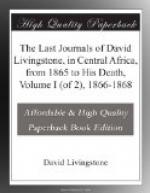Ohitikola was absent from Paritala when we arrived on some milando or other. These milandos are the business of their lives. They are like petty lawsuits; if one trespasses on his neighbour’s rights in any way it is a milando, and the headmen of all the villages about are called on to settle it. Women are a fruitful source of milando. A few ears of Indian corn had been taken by a person, and Chitikola had been called a full day’s journey off to settle this milando. He administered Muave[33] and the person vomited, therefore innocence was clearly established! He came in the evening of the 21st footsore and tired, and at once gave us some beer. This perpetual reference to food and drink is natural, inasmuch as it is the most important point in our intercourse. While the chief was absent we got nothing; the queen even begged a little meat for her child, who was recovering from an attack of small-pox. There being no shops we had to sit still without food. I took observations for longitude, and whiled away the time by calculating the lunars. Next day the chief gave us a goat cooked whole and plenty of porridge: I noticed that he too had the Assyrian type of face.
FOOTNOTES:
[25] Dr. Livingstone’s description of the “Sponge” will stand the reader in good stead when he comes to the constant mention of these obstructions in the later travels towards the north.—ED.
[26] So named when Dr. Livingstone, Dr. Kirk, and Mr. Charles Livingstone, discovered Lake Nyassa together.
[27] The sheep are of the black-haired variety: their tails grow to an enormous size. A rain which came from Nunkajowa, a Waiyau chief, on a former occasion, was found to have a tail weighing 11 lbs.; but for the journey, and two or three days short commons, an extra 2 or 3 lbs. of fat “would have been on it.—ED.
[28] This complaint has not been reported as an African disease before; it probably clings to the higher levels.—ED.
[29] A fine fibre derived from the shoots of a shrub (Securidaca Longipedunculata).
[30] Several superstitions of this nature seem to point to a remnant of the old heathen ritual, and the worship of gods in mountain groves.
[31] Hemp = bange is smoked throughout Central Africa, and if used in excess produces partial imbecility.—ED.
[32] The Hopo is a funnel-shaped fence which encloses a considerable tract of country: a “drive” is organised, and animals of all descriptions are urged on till they become jammed together in the neck of the hopo, where they are speared to death or else destroyed in a number of pitfalls placed there for the purpose.
[33] The ordeal poison.
CHAPTER VI.
Progress northwards. An African forest. Destruction by Mazitu. Native salutations. A disagreeable chief. On the watershed between the Lake and the Loangwa River. Extensive iron-workings. An old Nimrod. The Bua Eiver. Lovely scenery. Difficulties of transport. Chilobe. An African Pythoness. Enlists two Waiyou bearers. Ill. The Chitella bean. Rains set in. Arrives at the Loangwa.




